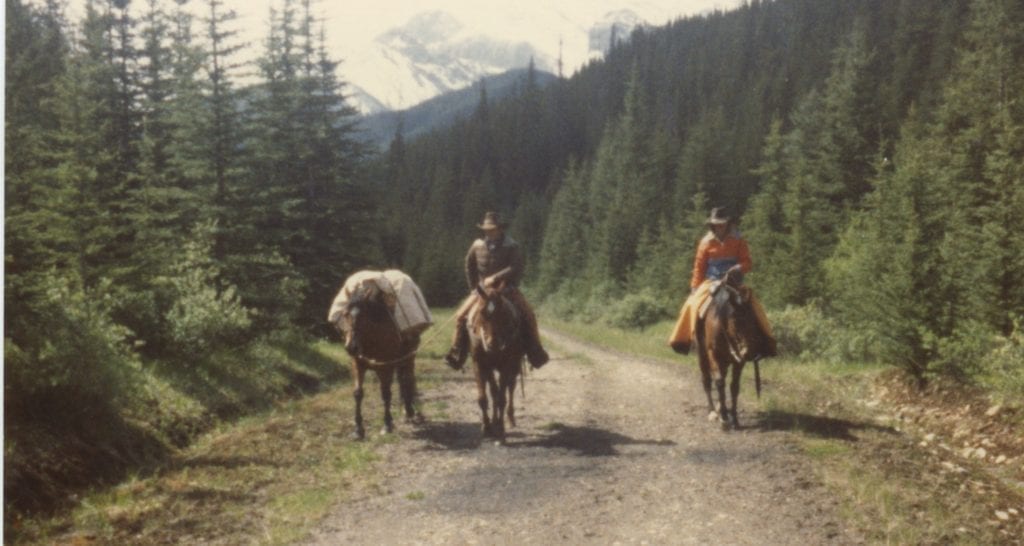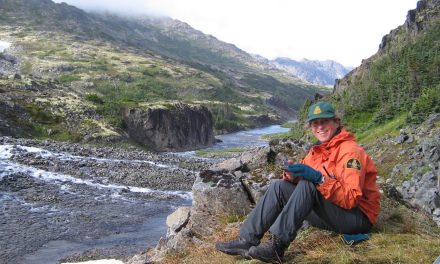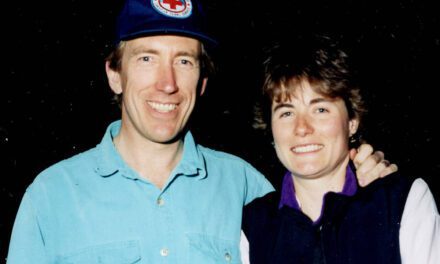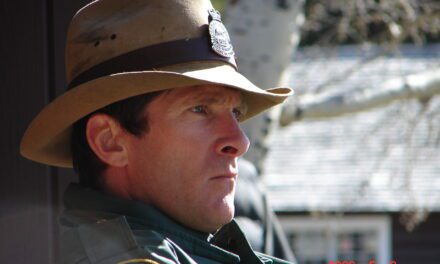It was a fantastic thing to start.
Oh yeah, I loved doing it! You would find stuff lying around like buffalo skulls. We found three or four buffalo skulls right on the ranch and fossils. I took pictures of arrowheads that the archeologists would find out there. And some of the description from the Luxton Museum of the eagle hunting pits because that is a really nice one out there. Now with the Friends of the Eastern Slopes Association (FOESA) I did a little description for their website (www.foesa.org) on how to find them for people when they are riding. Say on trail, such and such, watch for this, or at this point and teepee rings at this point and so on. So it makes it fun for the FOESA to read that and then go look for them.

Teepee ring west of Scalp Creek, Ya Ha Tinda Ranch. Marie Nylund photo.
(1:16:16) John – We used to see wolves and elk. One time I was watching and I saw this bunch of elk and they were all in a little group. They were on the east side of the canyon looking to the slope from the house and anyway here was four or five wolves lying down on a knoll. These elk were just a little ways away from them and they were all looking at them. Then they started to go closer to the wolves and all of a sudden this wolf stood up and they all just took off! Then they stopped and the wolf layed back down again and the elk all came back. They went closer and closer. The wolves jumped up to take after them and the elk all took off running again. Anyway they ran about 50 yards and the wolves stopped and they turned around and went back.
Were the wolves just playing?
John: Well, I think that is how they get them lots of times.
(1:17:22) Marie – Fool them into thinking that they are not serious.
(1:17:23) John – Another time I saw that cow take after that wolf. They ran, but the cow just chased it a little ways.
(1:17:31) Marie – And then that coyote you saw chasing that wolf, that was running down on the Scalp Creek flats, biting at the wolf’s tail. It must have killed its pups or something maybe, I don’t know. It was kind of odd. Another interesting scenario there.
(1:17:28) John – I heard this coyote yapping and I was riding. So I rode over to see if I could see him and here he was following a wolf. You know how coyotes yap? Then it would run up and nip the wolf. Then the wolf would turn around and chase it, the coyote would run a little ways. The wolf would stop, turn around and start going down the trail again. He went about right up to where the hay shed is, you know at the ranch? On the opposite side of Scalp Creek though on the flats. Then I just rode down there and scared them both. Anyways it was kind of funny.
(1:18:36) Did you have any serious issues with wildlife?
Marie – We didn’t have any injuries. But with the hunters, one guy said he shot this nice six point bull elk and put his tag on it. It was late in the day and he was kind of northeast of the ranch buildings. So he took off his sweaty t-shirt. He thought if he hung it on a tree it would have enough human scent to keep any bears away. Well, he was dead wrong! So he came to the buildings the next day and he wanted to use the phone because he said, “That grizzly has claimed my bull elk.” He wanted to phone Fish and Wildlife to see if he could get another tag.
(1:19:03) John – He (the bear) buried it, so it was no good to him then anyways.
(1:19:13) Marie – Of course he couldn’t get another tag. But we let him make his phone call. He was pretty heartbroken! Really they’ve got to take the time to get that meat out of there or they were going to lose it. Because those bears get really wise out there. We always said when they heard a rifle shot, it was like a dinner bell. They would just run to the shot. We always had to be really vigilant in the fall. I never rode in the bush in the fall. I would always stay in the open because I didn’t want to run into a gut pile and have a bad bear encounter. A lot of time I rode by myself. The potential was there to cross something like that.
(0:19:50) Marie – The only injuries that we really had were horse related, like the lady who got run over at the campground, but she didn’t get bucked off. One guy, he was from Drayton Valley, an older fellow too. He was riding this Appaloosa horse and he was the last one in a line of riders. They had ridden all day and they came back into the campground and everybody was watering their horses. He was the last guy and his horse was watering. A real bad mistake that a lot of people will do is ride off and leave a lone rider on a gate or something. This horse looked up and there were no other horses, so he panicked. He was always used to being a follower and he bucked Eldon off. He broke these ribs (demonstrating). Eldon was really in rough shape and of course he was in denial. He didn’t want to go anywhere. I just happened to come to the campground and this lady ran up and stopped me and she said, “I really think he has to go in an ambulance. Can you call an ambulance?” I said, ‘Oh sure, I can call you an ambulance.” They already had him sitting in a car and he said, “There is no way that I am going in an ambulance. No way!” So we were all kind of worried about him. I said to the driver, “If you get down to the Mountainaire (Lodge, 45 minutes from Sundre) and he starts getting way worse, there is a phone there, a landline. You can phone for an air ambulance, but just watch him.” Well it turned out that probably the best thing that he ever did was sit in the car. They said had he gone and laid down, he probably would have punctured a lung or something because the ribs were that badly broken. It was kind of a series of lucky things for him. They transported him sitting up. I don’t know if I ever saw him back at the campground, but I saw the other lady who had stopped me because she always came there every year. She always filled me in on how he was doing.
Did you go down to the campground every day?
(1:21:33) Marie – Yep every day. The guys would usually check it in the morning. Then I would usually go in the afternoon. Sometimes you would just ride through which was kind of good for your horse to get used to tents and all that stuff. The guys would ride the colts through because that was good training for the colts to get desensitized to the smell of all the different things and the sights, flapping tarps, dogs and kids on bikes. That kind of thing. And then you would meet people. We met a lot of really nice people in the campground and we still see them, time and time again.
(1:22:15) John – There was that airplane crash too when those two guys were killed. That happened when we were there. They were supposed to go up the Red Deer and they went up Scalp (Creek). They tried to turn around up there in that canyon and they didn’t make it.
(1:22:29) Marie – It was in May, so Rob (Jennings) was getting up every couple of hours to check the brood mares that were due to foal. He said he just got in the door and there was a loud knock. I think it was an RCMP officer and he said, “I need to get up in that area” It was north and west of the ranch on that old fire road. “There had been a plane crash up there. It happened yesterday afternoon.” This was during the Gulf War, so all the signals were scrambled. When that plane went down the GPS, no not the GPS, the ELT, it didn’t register correctly. It gave a wrong location for the plane. So then they finally got the army involved and they could unscramble it and figure it out. “This is where this plane is.” The RCMP officer thought he could just drive there and check this out and go get a visual on it. Rob says, “Well you can’t.” And he explained the situation. Then this group arrived. We were actually on days off. We got home and here are these police officers and investigators at the ranch. These poor guys…the fellow was training to eventually fly through to Vancouver in a month or two. And he just lost altitude.
(1:23:53) Marie – It was a double fatality. So then we had to deal with the press. The RCMP guys were there and the two fellows from the DOT (Department of Transportation) to do the investigation. They had to bring a chopper out to fly the remains out. They did it really well. They were very discrete about the whole thing. It was really well handled. A couple of days later they flew the actual wreckage out.
(1:24:46) John – There was not much left of the plane.
(1:24:47) Marie – So that was a bit upsetting for us. And for Rob, but Rob handled it really well.
(1:25:02) Marie – I had forgot about that one, but I kept journals that whole time that we were out there. So sometimes you read back through and relive all these things. You think “Gosh that was the most exciting seven years of our lives…”
(1:25:33) John – There was a guy coming to the campground in the winter one time and there was nobody else in the campground at all, but he drove in. His car was sitting there running for what….three or four days…..anyway, we phoned the RCMP in case he was wanted or something. But they had no record of the guy. He was just there. I don’t know why. Maybe he was trying to stay away from his wife for a day or two?
(1:26:07) John – He had us worried because he was sitting in his car. One time with his head against the window. I thought he was dead. The car was running. I tapped on the window and he woke up. And I asked him if he was allright. He said, “Oh yeah.”
(1:26:18) Marie – He’d been cooking. He had some cooking stuff, just little bits, like a little tiny stove.
(1:26:33) John – But he would just move every once and a while to a different spot in the campground and then finally he left one day. He was gone.
Can you see the campground from the ranch buildings?
(1:26:56) John – You can see the tops of the trees.
(1:26:57) Marie – You can’t see the tents, but in the morning you can see the plume of smoke when the first hunter lights their fire. It is about four kilometers.
(1:27:14) Marie – We used to see interesting horse wrecks. I remember sitting in the living room, you remember that beautiful panoramic view? I was sitting there one time and there was this horse running down the other side of the canyon, dragging all this pack stuff…Then you would see people walking and then people with the horse going back. So you knew that there had been a wreck! There was always horse wrecks. That was the other thing that you could easily run into on some of those trails. Somebody’s pack horse running loos

Johnny and Marie on Cascade Fire Road circa 1984. Photo Nylund collection. (Horses – Leaf, Rex and Skedaddle)



